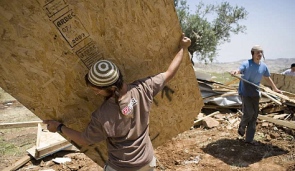Construction in Israeli settlements in the occupied West Bank has risen significantly since the end of a partial construction freeze
A week after the razing of illegal structures which prompted a series of protests and "price tag" activities, demolished structures in Havat Gilad have been rebuilt, Israeli newspaper Yediot Ahronot reported.
In addition, four new structures are being set up. Meanwhile, the government has pledged to demolish the buildings by the end of the year. "Our Zionist response to the destruction of the country is to build immediately, not just the razed structures but several other ones," Itay Zar, Havat Gilad founder said.
But residents of the neighboring village of Jit claim that the settlers are building on privately owned Palestinian land. "We demand that the State of Israel and security forces put a stop to the expansion of Havat Gilad," Zacharia Seda said. "These are farming lands which belong to the village, and the government must protect the residents and their property."
Jit residents claim that security forces avoid entering the area for fear of more settler protests. "We informed the Civil Administration of the settlers' activity several days ago but they do nothing to prevent this expansion," Seda said. He added that farmers can only work their land a limited number of days a year while the settlers roam the area freely.
Meanwhile, residents in the Givat Menachem outpost have also rebuilt razed structures, including a synagogue and several residential buildings.
Construction in Israeli settlements in the occupied West Bank has risen significantly since the end of a partial construction freeze, government statistics indicated. According to 2010 figures released by the Central Bureau of Statistics late on Monday, construction begun on 427 new housing units after the freeze expired at the end of September.
That was up from just 114 building starts in the first nine months of 2010, while the partial freeze was in place, the bureau said.
The Israeli Peace Now settlement watchdog group said their figures showed there was even more construction than the government had reported. Peace Now said the government statistics relied on reports from local councils and did not include illegal construction. The non-governmental group said its figures, based on site investigations and aerial photographs, showed more than 1,000 settlement housing starts between the end of the freeze and February 2011.
